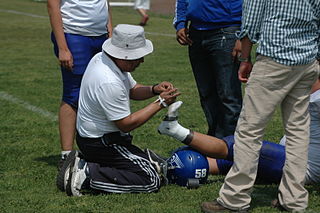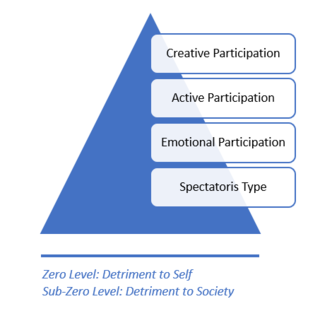Related Research Articles

Action sports, adventure sports or extreme sports are activities perceived as involving a high degree of risk. These activities often involve speed, height, a high level of physical exertion and highly specialized gear. Extreme tourism overlaps with extreme sport. The two share the same main attraction, "adrenaline rush" caused by an element of risk, and differ mostly in the degree of engagement and professionalism.

Sports injuries are injuries that occur during sport, athletic activities, or exercising. In the United States, there are approximately 30 million teenagers and children who participate in some form of organized sport. Of those, about three million athletes age 14 years and under experience a sports injury annually. According to a study performed at Stanford University, 21 percent of the injuries observed in elite college athletes caused the athlete to miss at least one day of sport, and approximately 77 percent of these injuries involved the knee, lower leg, ankle, or foot. In addition to those sport injuries, the leading cause of death related to sports injuries is traumatic head or neck occurrences.

Sociology of sport, alternately referred to as sports sociology, is a sub-discipline of sociology which focuses on sports as social phenomena. It is an area of study concerned with the relationship between sociology and sports, and also various socio-cultural structures, patterns, and organizations or groups involved with sport. This area of study discusses the positive impact sports have on individual people and society as a whole economically, financially, and socially. Sociology of sport attempts to view the actions and behavior of sports teams and their players through the eyes of a sociologist.

The participation of women and girls in sports, physical fitness and exercise, has been recorded to have existed throughout history. However, participation rates and activities vary in accordance with nation, era, geography, and stage of economic development. While initially occurring informally, the modern era of organized sports did not begin to emerge either for men or women until the late industrial age.

A sports coach is a person coaching in sport, involved in the direction, instruction and training of a sports team or athlete.

Sex verification in sports occurs because eligibility of athletes to compete is restricted whenever sporting events are limited to a single sex, which is generally the case, as well as when events are limited to mixed-sex teams of defined composition. Practice has varied tremendously over time, across borders and by competitive level. Issues have arisen multiple times in the Olympic games and other high-profile sporting competitions, for example allegations that certain male athletes attempted to compete as women or that certain female athletes had intersex conditions perceived to give unfair advantage. Sex verification is not typically conducted on athletes competing in the male category.
Mediatization is a process whereby the mass media influence other sectors of society, including politics, business, culture, entertainment, sport, religion, or education. Mediatization is often understood as a process of change or a trend, similar to globalization and modernization, where the mass media are integrated to an increasing degree into other sectors of the society. Political actors, opinion makers, business organizations, civil society organizations, and others have to adapt their way of communication to a form that suits the needs and preferences of the mass media – the so-called media logic. Any person or organization who want to spread their messages to a larger audience have to adapt their messages and communication style to make it attractive for the mass media.

Sport psychology was defined by the European Federation of Sport in 1996, as the study of the psychological basis, processes, and effects of sport. Otherwise, sport is considered as any physical activity where the individuals engage for competition and health. Sport psychology is recognized as an interdisciplinary science that draws on knowledge from many related fields including biomechanics, physiology, kinesiology and psychology. It involves the study of how psychological factors affect performance and how participation in sport and exercise affect psychological and physical factors. Sport psychologists teach cognitive and behavioral strategies to athletes in order to improve their experience and performance in sports. In addition to instruction and training of psychological skills for performance improvement, applied sport psychology may include work with athletes, coaches, and parents regarding injury, rehabilitation, communication, team building, and career transitions.
Mental toughness is a measure of individual resilience and confidence that may predict success in sport, education and the workplace. As a broad concept, it emerged in the context of sports training, in the context of a set of attributes that allow a person to become a better athlete and able to cope with difficult training and difficult competitive situations and emerge without losing confidence. In recent decades, the term has been commonly used by coaches, sport psychologists, sports commentators, and business leaders.
Somatotype is a highly disputed taxonomy developed in the 1940s by the American psychologist William Herbert Sheldon to categorize the human physique according to the relative contribution of three fundamental elements which he termed somatotypes, classified by him as ectomorphic, mesomorphic, and endomorphic. He created these terms borrowing from the three germ layers of embryonic development: The endoderm,, the mesoderm, and the ectoderm. Later variations of these categories, developed by his original research assistant Barbara Heath, and later by Lindsay Carter and Rob Rempel, are still in occasional academic use.
Sports communication is an aspect of communication studies that specializes in the study of communication in a sports setting. It encompasses the study of interpersonal and organizational communication between participants within a sport, fans, and the media; and the way that sports are represented and communicated in the media. Sports communication is not restricted to professionals only, it is something that happens at different levels of play, ranging from preschool to college level. Communication happens constantly in sport, and works best with people that are willing to work well as a team and is vital for the success of a program. Studies have found that communication in sport can be both positive and negative due to evidence supporting a connection between communication and cohesion.
Health issues of athletics concern the health and well-being of athletes who participate in an organized sport. If athletes are physically and mentally underdeveloped, they are susceptible to mental or physical problems. Athletes trying to improve their performance in sports can harm themselves by overtraining, adopting eating habits that damage them physically or psychologically, and using steroids or supplements.
Concussions, a type of mild traumatic brain injury, are a frequent concern for those playing sports, from children and teenagers to professional athletes. Repeated concussions are known to cause neurological disorders, particularly chronic traumatic encephalopathy (CTE), which in professional athletes has led to premature retirement, erratic behavior and even suicide. A sports-related concussion is defined as a "complex pathophysiological process affecting the brain, induced by biomechanical forces". Because concussions cannot be seen on X-rays or CT scans, attempts to prevent concussions have been difficult.

The term relative age effect (RAE), also known as birthdate effect or birth date effect, is used to describe a bias, evident in the upper echelons of youth sport and academia, where participation is higher amongst those born earlier in the relevant selection period than would be expected from the distribution of births. The selection period is usually the calendar year, the academic year or the sporting season.
Disability sport in Australia encompasses individuals with different disabilities, of all ages and skill levels from recreational to professional, participating in sport in Australia. The apex of disability sport in Australia is the Paralympics. Australia's participation at the Paralympics began with the inaugural 1960 Summer Paralympics and 1976 Winter Paralympics. Australia hosted the 2000 Summer Paralympics in Sydney.
The participation of transgender people in competitive sports, a traditionally sex-segregated institution, is a controversial issue, particularly the inclusion of transgender women and girls in women's sports.

Nash's Pyramid is a framework for ranking leisure activities, developed by Jay B. Nash. Nash was an early leader in the leisure field. His thinking was influenced by the prevalence of 'Spectatoritis' in America which he defines as, "a blanket description to cover all kinds of passive amusement".

Velocity based training (VBT) is a modern approach to strength training and power training which utilises velocity tracking technology to provide rich objective data as a means to motivate and support real-time adjustments in an athlete's training plan. Typical strength and power programming and periodisation plans rely on the manipulation of reps, sets and loads as a means to calibrate training stressors in the pursuit of specific adaptations. Since the late 1990s, innovations in bar speed monitoring technology has brought velocity based training closer to the mainstream as the range of hardware and software solutions for measuring exercise velocities have become easier to use and more affordable.
Athletic identity is a part of self-identity and can be defined as the level, to which one identifies with the role of an athlete. It is a self-concept that is constructed from information processed by the individual and influences both input and output of information related to the self. For athletes and people that are actively involved in sports, athletic identity is a major part of their self and they can satisfy the need of their athletic identity by taking part in sports. Athletic identity increases with the level of involvement in sports, and strong athletic identity correlates positively with athletic achievements, as well as with higher motivation and competitiveness. Changes, such as a decline, in athletic identity facilitate adjustment to everyday life.
A variety of forms of abuse have been reported in gymnastics, including physical, emotional, and sexual abuse. Abuse has been reported in multiple countries including Australia, Brazil, Portugal, the United Kingdom, and the United States.
References
- ↑ Bouthier, Daniel; Godbout, Paul; Gréhaigne, Jean-Francis (1997). "Performance Assessment in Team Sports". Journal of Teaching in Physical Education. 16 (4): 500–516. doi:10.1123/jtpe.16.4.500 . Retrieved 20 July 2022.
- Beamish, Rob; Ritchie, Ian (2006-09-27). Fastest, Highest, Strongest: A Critique of High-Performance Sport . Routledge. ISBN 9781135987084 . Retrieved 18 August 2016.
- Bergsgard, Nils Asle; Houlihan, Barrie; Mangset, Per; Svein Ingve, Nødland; Hilmar, Rommetvedt (2009-11-04). "High performance sport". Sport Policy. Butterworth-Heinemann. pp. 152–199. ISBN 9781136364686 . Retrieved 18 August 2016.
- Green, Mick (2004). "Changing policy priorities for sport in England: the emergence of elite sport development as a key policy concern". Leisure Studies. 23 (4): 365–385. doi:10.1080/0261436042000231646. ISSN 0261-4367. S2CID 145048046.
- Grix, Jonathan; Carmichael, Fiona (2012). "Why do governments invest in elite sport? A polemic". International Journal of Sport Policy and Politics. 4 (1): 73–90. doi:10.1080/19406940.2011.627358. ISSN 1940-6940. S2CID 153350698.
- Hanstad, Dag Vidar; Skille, Eivind Å. (2010-03-31). "Does elite sport develop mass sport? : a Norwegian case study" (PDF). Scandinavian Sport Studies Forum. Malmö University (1): 51–68. hdl:11250/170845. Archived from the original (PDF) on 2013-12-08. Retrieved 2021-02-10.
- Pringle, Richard (2001). "Examining the Justifications for Government Investment in High Performance Sport: A Critical Review Essay". Annals of Leisure Research. 4 (1): 58–75. doi:10.1080/11745398.2001.10600891. ISSN 1174-5398. S2CID 154411069.
- Sotiriadou, Popi; Bosscher, Veerle De (2013). Managing High Performance Sport. Routledge. ISBN 9780415671958 . Retrieved 18 August 2016.